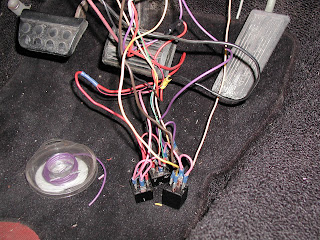First I discovered that one of my main contactors was defective. Because of the slow response from the vender it took quite a while just to purchase a replacement. I still have not heard anything back on the defective one I returned to them.
After I installed the replacement contactor, I encountered the perplexing problem of voltage from my 156 volt battery pack finding its way into the chassis of the car. It took a full day to finally diagnose and rectify that little issue. The cause was my steel battery restraints that I had worked extremely long and hard to fabricate and install. I removed most of them to alleviate the problem but will still have to correct them in the future.
So I finally got to a point where I was satisfied that everything was working correctly and safely, and took my first test drive. Of course that is the day I discovered (with a bang) that LogiSystems had been sending out defective controllers. That unit has been sent back to LogiSystems but I am still uncertain if they have corrected the issue with their product that precipitated this disaster. I have made no decision yet as to how to proceed. Rather than spend another $1600, I am giving LogiSystems a little time to make things right if they can.
If November wasn't bad enough already, I capped the month off with a mistake purely of my own making. I had already connected my Manzanita Micro battery charger but had never used it. Being in 'waiting mode' I wanted to at least charge my battery pack. I plugged it into a 120 volt outlet and the charger came alive. However it wasn't putting out any voltage.
In trying to diagnose the problem, I wanted to verify that I had at least connected it correctly. I went through all of my documentation and absolutely could not find any paperwork or instructions on which DC wire was which. I had connected it a while back and could not remember why I connected it the way I did. Even though I had already downloaded several files pertaining to this charger, not one of them instructed which DC wire was positive and which was negative.
I had to go online again and find and download another file at the Manzanita Micro website. Then I had to find a way to open the file since my computer did not have Microsoft Word installed on it. Finally, after quite some time I found what I suspected. Yup, I had connected the DC leads backwards. In this installation file, I also found the words "...something will be destroyed in either the car or the charger. The charger warranty does not cover this installation error".
Oh crap! I have been so careful and deliberate on this project, I don't know HOW I could have made such an idiotic mistake.
Of course my phone call and email to Manzanita Micro have not yet been returned, since this occurred on the Friday after Thanksgiving. Interestingly, I also found this on the newly downloaded installation and setup file: "The charger is protected from reverse polarity installation by an internal fuse". Hmmm, that's kind of contradictory to their prior statement of "something will be destroyed". Maybe what it means is that I have to send it back to them, wait weeks and spend hundreds of dollars for them to replace an internal fuse!
I'm so glad this is the last day of November. I am not going anywhere near the damn car today.


























